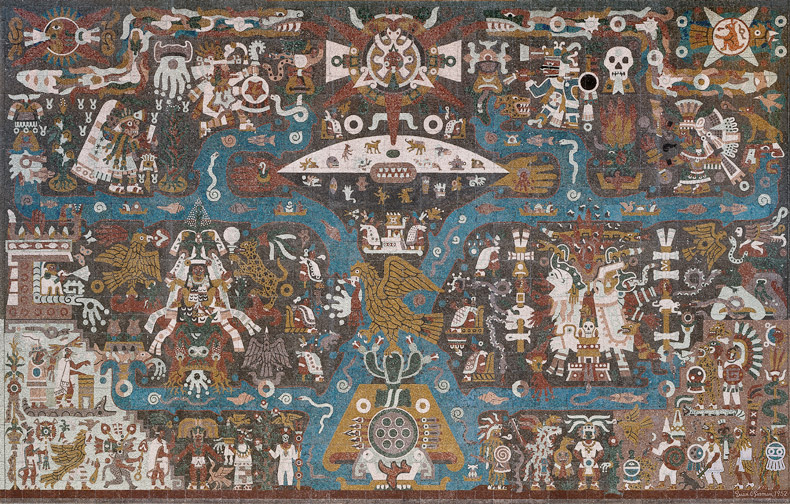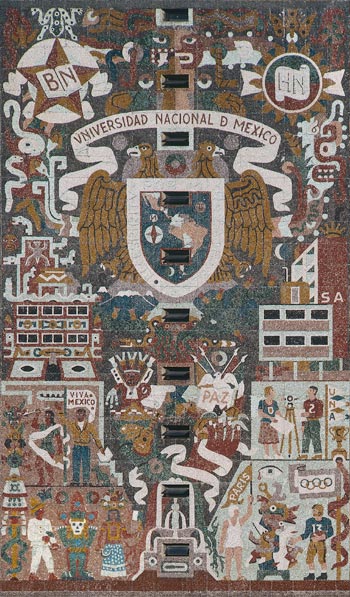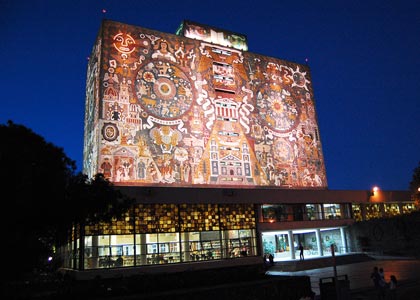Nowhere is Mexico´s love of their pre-Hispanic heritage more apparent than in the stunning central library of the UNAM (Universidad Nacional Autonoma de Mexico), in the southern part of Mexico City.
Ten stories tall, the building is covered in its entirety by mosaic stone murals depicting the history of Mexico. The building was built by architects Gustavo Saavedra and Juan Martínez de Velasco, and the murals conceived and executed by artist and architect, Juan O´Gorman. Began in 1948, the building took four years to complete and the stone mosaic murals cover 4,000 square meters. Amazingly all of the stones (even the bright blues) are in their natural colors, O´Gorman travelled all across Mexico to find the perfect stones. He chose to use natural occurring colors because painting the stones would have required constant renovating and re-painting. In the state of Guerrero they found the yellow, red, black and green stones. Some of the green stones were also found in the state of Guanajuato, and in Hidalgo they found volcanic rock that was in the hues of purple and pink. The blue was the hardest to find, but they finally found the blue stones in a mine in Zacatecas. The Central Library (La Biblioteca Central) is located in the north part of University City (Ciudad Universitaria), about a block east of Insurgentes, and two blocks south of Universidad. O´Gorman´s masterpiece is a fascinating testament to Mexican history, and the progressive socialist movement that was going on at that time period in Mexico. Sadly the trees have grown up to partially obscure one side and it is largely ignored by the thousands of university students who pass by it daily, but it´s an impressive site and worth visiting in you are near the capital.
North Wall: Pre-Hispanic
The entrance to the library is flanked by a volcanic rock wall depicting the rain god Tláloc, and above it is the north side of the building, covered by the most ornate of the murals, the Pre-Hispanic. The central theme of this mural is the lake capital of Tenonchitlan. It is divided by channels of water into two sides, each side having three vertical sections. Along the canals there are representations of the principal villages that surrounded the capital: Coyoacán, Churubusco, Iztapalapa, Xochimilco, Azcapotzalco and Tacuba. The central image reflects the founding of Tenochtitlán, the legend of the eagle and the cactus, and above that is a representation of the Sun Stone, also known as the Aztec calendar. In the top left is the sun, the principal deity of pre-Hispanic Mexico, and throughout are displayed many of the rest of the pantheon of gods of Mesoamerica: the gods of rain, wind, agriculture, fertility…along with many images and symbols of ancient Mexico.
South Wall: Colonial Times
The south wall represents the Spanish colonial time period in Mexico, from the year of conquest in 1521 to Independence in 1820. The mural is divided into two parts, left for the colonial world and right for the indigenous world. The mural depicts the clash of the two vastly different cultures. The right side is covered by the sun, the left side by the moon and in the middle is the two-headed eagle, (part of the coat of arms of the university), one eagle looking back to Mexico before Spain, the other looking forward to Mexico after Spain. Interspersed are symbols of the Catholic Church, wars, and the changes in the world views of the time, most prominent is the comparison between the Ptolemaic view that the earth was the center of the universe and the Copernican view that the earth revolved around the sun. Along with images of prominent figures and events of that time period, Hernan Cortez, Fray Diego de Landa, the burning of Mayan codices, and symbols of the lasting effects of colonialism to the present day: colonial architecture and the Virgin Mary.
East Wall: Contemporary
The east wall mural depicts the contemporary Mexico (or at least up until 1950). Again separated into sun and moon, light and dark, its central image immediately tell us the mural was created in the atomic age. A product of Mexico´s progressive, socialist-nationalist movement of that time period, O´Gorman equates the struggle of the modern man with worker´s rights. On the left hand side he has symbols of industry, on the right the agrarian life, all underscored by images of the biggest contemporary struggles of Mexican society: Independence and Revolution.
West Wall: The University
The university itself is an optimistic symbol of nationalism and University City was created during the same time period. UNAM was founded in 1921, but was not moved into its own “City” until 1945. The mural of the east wall celebrates the philosophy of higher learning, the humanistic goals of the university, and the achievements the UNAM has accomplished. The central part is the seal of the university, the two-headed eagle, with its motto: “The spirit shall speak for my race” (“Por mi raza hablará el espíritu”). The mural depicts the different areas of study at the university, also the sports and activities of the students (including Mexico´s inclusion in the Olympics). The traditional dress of the people shown reflects the goals of the university to be a university of the people. Unfortunately this is the wall most obscured by trees, covering at least half of the mural. Never one to suggest chopping down trees, perhaps someone will consider relocating them.
For the scope of imagination and the time and effort required, the murals of the UNAM central library are an architectural wonder. It is hard to imagine the time and precision it must have taken to place each stone–it calls to mind another Mexican art form, the intricate bead work of the Huichol–and makes me wonder if perhaps thousands of tiny stones forming an enormous image is not the perfect analogy for history itself. More information about the UNAM central library can be found on their official website, http://bc.unam.mx/








